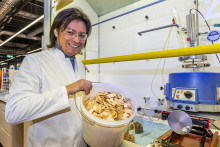Cyrene is a promising new green solvent that may phase out different chemicals that are currently used. But, also a more ‘common’ sustainable component like lactic acid has shown potential. Schuur: ‘We are looking for applications and try to solve problems and limitations using these natural chemicals. For example, by changing their properties by mixing them with other components.’
‘This is lactic acid, a natural solvent that we use to breakdown wood into different fractions,’ scientist Alan Perez Ávila says, while he takes off the lid from a round flask with a boiling fluid inside. One by one he puts a handful of wood chips into the boiling liquid. Then the pieces are left to boil for three hours. ‘This new mild extraction method slowly separates the different wood components,’ Perez Ávila says. ‘This, allows the recovery of not only cellulose, but also other useful substances present in wood like lignin and hemicellulose.’

After the cooking time, the boiling mixture has turned into a dark black fluid containing the different wood components that can be recovered for different applications. Perez Ávila grabs a bottle that contains material from a previous experiment and takes out a light-brown, fibrous material. ‘This is the cellulose fraction, that can be used as a raw material for paper,’ he says. In a second bottle, the other fraction is collected: a sticky, black fluid containing a mixture of dissolved lignin and hemicellulose.
Milder extraction
Perez Ávila’s experiment is especially relevant for the paper industry. They usually extract cellulose from wood by a procedure using heavy duty chemicals. But in that process, other wood materials like lignin and hemicellulose are lost. That is a waste, since it is a valuable biopolymer that can be used to make, for example, bioplastic. Also, hemicellulose is a precious resource and can be used in many different applications like hydrogels, coatings, cosmetics, and pharmaceuticals.
‘Our experiments are exploring the possibilities to extract not only cellulose, but also preserve lignin as well as hemicellulose by cooking wood in a mixture of lactic acid,’ Professor Boelo Schuur explains. ‘This is a slow and relatively delicate ‘al dente’ method to harvest the different components without destroying them.’ The results of Perez Ávila’s experiments show that manufacturing paper can be more sustainable and efficient by using lactic acid, a biobased solvents that perform a milder extraction and a consequent better recovery of valuable materials. According to Schuur, lactic acid is just one of the possibilities where traditional solvents used in industrial processes can be replaced with green solvents.

Difficult to recycle
Despite the promising applications of green chemicals, most chemical industries still use a wide variety of industrial, often toxic, chemicals in their production processes. Many of these substances are difficult to recycle and sometimes they are toxic. Often, they are made from oil, but that is a finite resource. Therefore, a transition to using more sustainable materials in their production processes, is crucial. Plant-based materials from, for example, organic waste or cultured algae, are excellent raw materials that can often replace oil-based chemicals for industrial production processes and products. For instance, polylactic acid is a biodegradable, plant-based material produced from corn starch or sugar cane, that can be used as a sustainable alternative for oil-based plastics. But also for important industrial separation processes, like extractions and distillations, the traditional oil-based solvents can be replaced by ‘green’ solvents.
Chemical properties
Distillation is a crucial industrial process where a mixture of fluids is separated based on their differences in boiling point. For example, alcohol and water can be partially separated by distillation due to the lower boiling point of alcohol: 78 °C versus 100 °C for water. At low alcohol concentrations, the alcohol will evaporate quicker and easier than water. At high alcohol concentrations the distillation is problematic. In many similar cases, where the boiling points of the components present in a chemical mixture are close together, or even overlap, a good distillation-based separation is difficult. The chemical industry tackles this problem by adding special solvents, that interact with one or more of the chemicals present. This changes their volatility. Consequently, the bigger difference between the boiling points results in a better and easier separation. ‘Currently, almost all industries use oil-based chemicals to enhance their distillation-based separation processes,’ Schuur says. ‘But these components are highly toxic and should therefore be replaced by more sustainable alternatives.’

Green solvent
Such sustainable industrial solvents became recently available. ‘On a conference, I heard about an alternative solvent, called Cyrene, that could replace the current solvents in some chemical production processes,’ Schuur says. ‘A Tasmanian start-up, called the Circa Group, manufactured this ‘green’ solvent from cellulose, present in wood.’
Cyrene is a small molecule that dissolves in water, but also in many oil-based mixtures. Cyrene is chemically similar to current solvents making this compound very suitable to apply in many industrial distillation processes. In different experiments, Schuur and his team showed that Cyrene could replace several currently used toxic solvents. In addition to using this ‘green’ solvent instead of a toxic oil-based chemical, the energy required for the distillation process is about 30 percent less than using conventional methods. However, Cyrene does not provide a solution for every distillation challenge, and therefore the group of Schuur is trying to find solutions with other biobased chemicals, and with blends of solvents as well.
The relevance and practical applications of Schuur’s research is obvious: a more biobased society with less toxic components used in the manufacturing process. Schuur: ‘If we manage to make the chemical industries more biobased, than we can set a big step towards a more sustainable and greener society. Green solvents are an important step to achieve that.’







